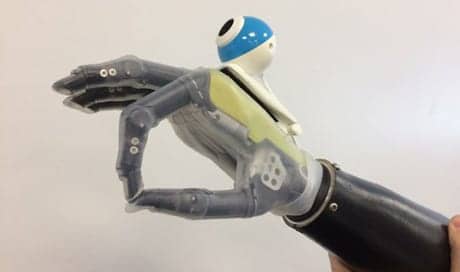
This prosthetic “hand that sees” has a camera attached to it that sees the object, chooses the most appropriate grasp, and sends a signal to trigger it to pick up the object. (Photo courtesy of Newcastle University)
Biomedical engineers at Newcastle University in the United Kingdom have developed a bionic hand that is able to allow the wearer to reach for objects automatically, without thinking.
Making this ability possible is a small camera placed upon it that instantaneously takes a picture of the object in front of it, assesses its shape and size, and stimulates the muscles in the arm to trigger a movement in the prosthetic limb.
In this way, the prosthetic hand “sees” and reacts in one fluid movement, according to a media release from Newcastle University.
Findings from a study on the prosthetic hand are published in the Journal of Neural Engineering.
“Using computer vision, we have developed a bionic hand which can respond automatically—in fact, just like a real hand, the user can reach out and pick up a cup or a biscuit with nothing more than a quick glance in the right direction,” says Dr Kianoush Nazarpour, a senior lecturer in Biomedical Engineering at Newcastle University, in the release.
“Responsiveness has been one of the main barriers to artificial limbs. For many amputees the reference point is their healthy arm or leg, so prosthetics seem slow and cumbersome in comparison.
“Now, for the first time in a century, we have developed an ‘intuitive’ hand that can react without thinking,” he adds.
Using a 99p camera fitted to the prosthesis, the hand “sees” an object, picks the most appropriate grasp, and sends a signal to the hand—all within a matter of milliseconds, and ten times faster than any other limb currently on the market, the release explains.
“The beauty of this system is that it’s much more flexible and the hand is able to pick up novel objects—which is crucial since in everyday life people effortlessly pick up a variety of objects that they have never seen before,” Nazarpour says.
The work is part of a larger research project to develop a bionic hand that can sense pressure and temperature and transmit the information back to the brain, per the release.
The ‘hand that sees,” Nazarpour adds, is an interim solution that will bridge the gap between current designs and the future.
“It’s a stepping stone towards our ultimate goal,” he states. “But importantly, it’s cheap and it can be implemented soon because it doesn’t require new prosthetics—we can just adapt the ones we have.”
[Source(s): Newcastle University, Science Daily]




